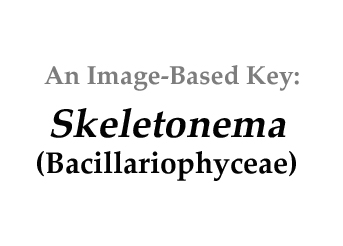|
Home / Bacillariophyceae / Centric / Filaments / Skeletonema |
||||
|
|
||||
|
Click on images for larger format |
||||
Name derivation: |
||||
|
Greek skeleto meaning "skeleton" and nema meaning "threads."
|
||||
Classification: |
||||
|
Skeletonema Greville 1865; 20 of 21 species descriptions are currently accepted taxonomically (Guiry and Guiry 2013). Order Thalassiosirales; Family Skeletonemataceae
|
||||
Morphology: |
||||
|
Silicaceous threads extend from the valve surface arranged in one marginal ring, connecting the individual cells in chains. One labiate process is located inside the ring close to the valve center. Threads are visible in girdle view and have fingerlike hooks that connect to one another. May appear as a single cell in valve view. Diameter 2 – 38 μm.
|
||||
Similar genera: |
||||
|
Detonula. Thalassiosira -- Connects cells with one thread from the central process. Spines project outwards from the marginal process. Can also form colonies with muscilage. The threads extending from the valve surface connecting the individuals with fingerlike hooks is unique to Skeletonema . The connecting threads are usually destroyed by preservation and are mainly present as single cells in a preserved sample. In this case they can be confused with Coscinodiscus when in the girdle view.
|
||||
Increase in S-containing osmolyte during nutrient deficiency |
||||
Exponentially growing axenic cultures of Skeletonema marinoi in artificial seawater at 15 C depleted the P, N, and Si concentrations of their media within 4 – 6 days as the cell concentration increased to > 2 x 106 cells ml-1. Under these conditions the cellular osmolyte dimethylsulfopropionate (DMSP) increased as the cultures approached stationary phase). S. marinoi has cellular levels of DMSP similar to other producers such as Emeliana huxleyi (Spielmeyer and Pohnert 2012), thus plays a major role in the release of dimethyl sulfoxide (DMS) released into the atmosphere and acts as a nucleator for cloud formation, ultimately affecting global weather patterns.
|
||||
Habitat: |
||||
|
Common. Found in both marine and freshwater (Hasle and Evensen 1976) habitats that range from the northern cold water region to temperate region to the southern cold water region. Can be found off in the Indian Ocean, Equatorial Atlantic Ocean as well as off the coast of Uruguay, Brazil and and the Norwegian south coast. Grows well in culture; has been used frequently in physiological studies (Guiry and Guiry 2013). |
||||
References: |
||||
|
Guiry. M.D. and G.M. Guiry 2013. AlgaeBase. World-wide electronic publication, National University of Ireland, Galway. http://www.algaebase.org; searched on 21 Dec 2013. Hasle, G.R., and D.L. Evensen 1976. Brackish water and freshwater species of the diatom genus Skeletonema. II. Skeletonema potamos comb. nov. Journal of Phycology 12:73-82. Hasle, G. et al. Identifying Marine Phytoplankton. Academic Press. (1997). Spielmeyer, A., and G. Pohnert 2012. Daytime, growth phase and nitrate availability dependent variations of dimethylsulfoniopropionate in batch cultures of the diatom Skeletonema marinoi. Journal of Experimental Marine Biology and Ecology 413:121-130. |
||||
|
Home / Bacillariophyceae / Centric / Filaments / Skeletonema |
||||






